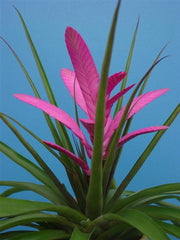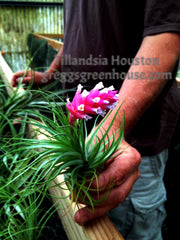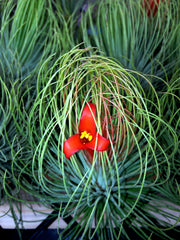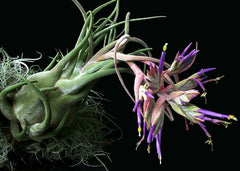Gregg's Greenhouse
Tillandsia - Air Plants
Tillandsia General Care
Tillandsias are popularly known as air plants. They are in the Bromeliad family (related to Pineapples and SpanishMoss). They are most often found in frost-free, humid areas from Florida, the Caribbean and throughout Central and South America, growing on rocks and trees without soil.
Contrary to the common myth that they are carefree and live "on air..." (You'd be astonished at how many times people have told me that!) ...Tillandsias are living plants that require the same basic culture as most other living things: sunlight, air and water.
LIGHT
Tillandsias thrive outdoors in warm climates where theyprefer bright, filtered light. Direct sunlight ONLY in the early to mid-morning is beneficial, but in strong, harsh afternoon sunlight they become dry and stressed and will suffer. If the light feels uncomfortable to you and would give you sunburn, it will do the same to your plants- possibly even kill them. You can also grow your Tillandsia indoors near a bright window in bright filtered light or under lights using appropriate fluorescent bulbs. A general rule of thumb is that Tillandsias with greener and softer leaves like a little more frequent watering and a bit of shade.
WATER
As mentioned, allthough Tillandsias are called "Air Plants" they do need water to survive.
Thoroughly wet (soak or drench) your Tillandsia 2-3 times per week: more often in a hot, dry environment.
Plants should be given enough light and air circulation to dry in no longer than 4 hours after watering. They do not like being soaking wet for long periods.
Occasional spray misting from a bottle is insufficient as the sole means of watering but may be beneficial between regular watering in dry climates to increase the humidity.
Tillandsias will not survive in standing water.
If your plant is not getting enough water, the leaves will look thin and curled inward, and in extreme cases the leaves will dry at the tips and begin to die back. If this occurs, soak it more frequently. The greener and softer varieties like a little more water and shade.
TEMPERATURE
Optimum temperature range for Tillandsias is 45 - 95 degrees F. A few can tolerate colder temperatures, but a good rule of thumb is to protect them from frost.
FERTILIZE
Fertilize monthly from Spring to Fall using a balanced "bloom" formula for use in growing orchids, usually readily available at most garden centers. Use no more than 1/4 strength. Too much fertilizer can burn your Tillandsia. Avoid high nitrogen fertilizer, as it may prevent them from blooming at all.






